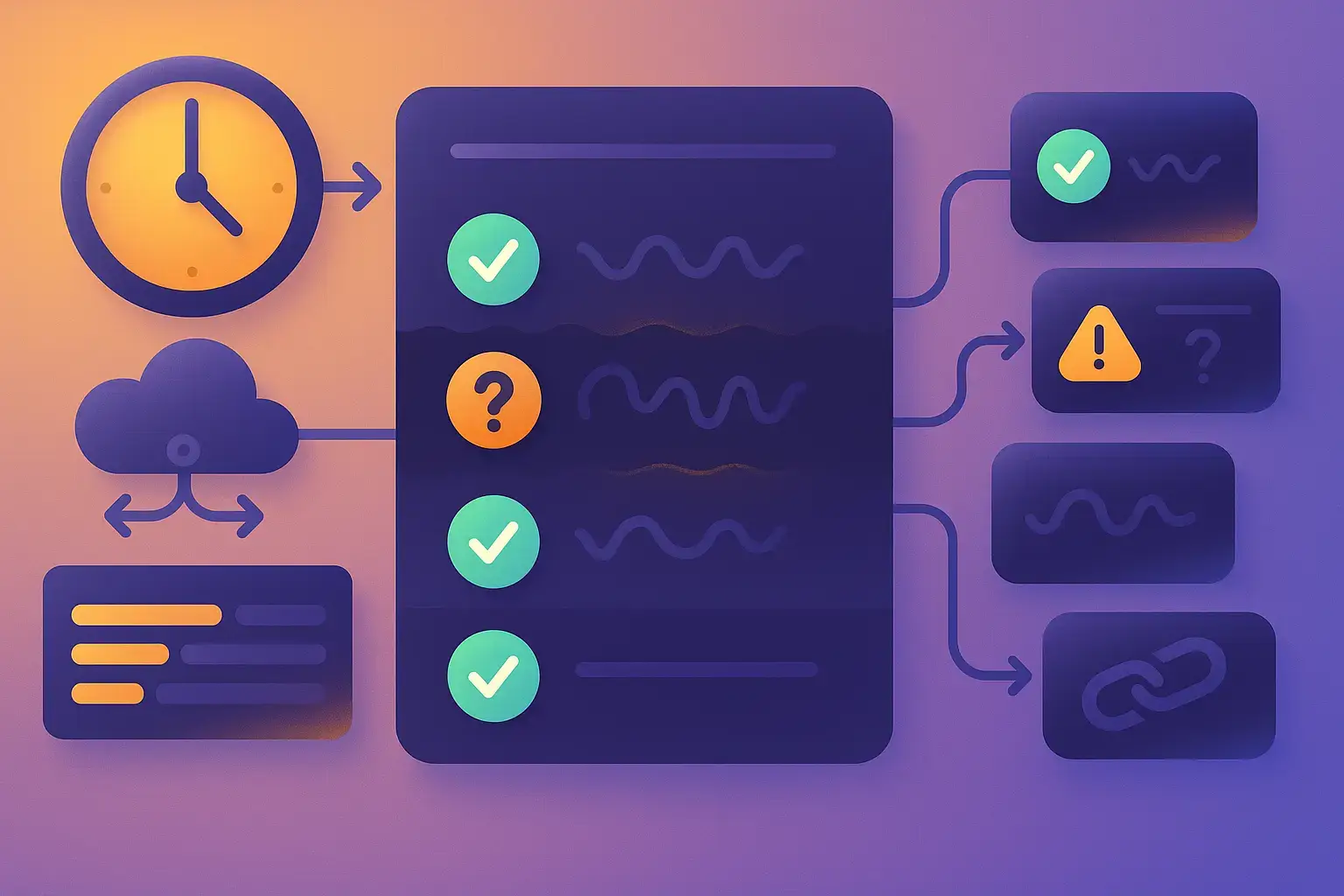What is a Flaky Test?
A flaky test is essentially the drama queen of your test suite. Sometimes it passes, sometimes it fails, and there’s no apparent rhyme or reason to its mood swings. Stable tests consistently return the same results for the same code, while flaky tests give different results when run multiple times against the same code base.
For example, imagine a flaky test example that checks if a user can log into your application:
function testUserLogin() {
// Navigate to login page
// Enter credentials
// Click login button
// Assert user is logged in
}
If this test sometimes succeeds and sometimes fails without any changes to the application code or test script, you’ve got yourself a flaky test.
The impact is huge. Developers start ignoring failures because “it’s probably just that flaky test again.” The CI/CD pipeline becomes unreliable. Release confidence drops. And suddenly, everyone’s spending more time investigating false alarms than building new features.
In the worst cases, teams start disabling tests altogether, defeating the entire purpose of automated testing. That’s why understanding and addressing test flakiness is essential for maintaining healthy development.
Characteristics of Flaky Tests
You know a flaky test when you see one, but they don’t all fail for the same reasons. Each type of flakiness has its own telltale signs, and recognising these patterns is the first step to actually fixing them instead of just re-running until they magically pass. Here are the usual suspects:
- Inconsistent results: The most obvious sign is that they pass and fail randomly when run against the same code.
- Environment sensitivity: They’re often highly dependent on specific conditions like timing, system resources, or network connectivity.
- Order dependency: They pass when run alone but fail when run as part of a test suite (or vice versa).
- Resource competition: They fight with other tests for shared resources, causing unpredictable outcomes.
- Time sensitivity: They rely on specific timing conditions or make assumptions about how quickly operations complete.
- Hidden state: They depend on a state that isn’t reset properly between test runs.
- Race conditions: They assume sequential execution, where parallel processes might be happening.
- Excessive complexity: They’re often far more complex than necessary, increasing the chances of inconsistency.
These characteristics make flaky tests particularly hard to debug since they don’t fail consistently. You can’t rely on the usual debugging approach of “reproduce, isolate, fix” because reproduction itself is hit-or-miss.
The real challenge with flaky tests isn’t just that they fail unpredictably. They also mask genuine issues. When your team starts dismissing test failures as “probably just flakiness,” you’ve entered dangerous territory where actual bugs could be hiding in plain sight. Effective flaky test detection becomes essential in this scenario.
What Causes Flaky Tests?
Once you can spot flaky tests, the next question is why they’re acting up in the first place. Most flaky tests fall into predictable categories of bad behaviour, and knowing which type you’re dealing with makes the fix much clearer:
- Asynchronous operations: Tests that don’t properly handle asynchronous code, like waiting for AJAX calls to complete or animations to finish.
- Race conditions: When two or more operations compete for resources or depend on a specific execution order that isn’t guaranteed.
// Example of potential race condition
createUser();
// Test immediately tries to check if user exists without ensuring creation completed
expect(userExists()).toBe(true);
- Time dependencies: Tests that rely on specific timing or make assumptions about execution speed.
// Example of time dependency
clickButton();
// Hardcoded wait that might be too short on slower environments
Thread.sleep(1000);
expect(elementToBeVisible()).toBe(true);
- External dependencies: Tests that interact with systems beyond your control, like third-party APIs or databases.
- Shared state: Tests that share resources or state with other tests, creating unexpected interactions.
- Improper test isolation: Tests that don’t properly clean up after themselves, affecting subsequent test runs.
- Environmental inconsistencies: Differences between development, CI, and production environments.
- Resource limitations: Tests that fail under high load or when system resources are constrained.
- Non-deterministic functions: Using random number generators, date/time functions, or other unpredictable elements without proper mocking.
- Implicit ordering assumptions: Tests that assume a specific order of operations without enforcing it.

Each of these causes requires a different approach to fix, but identifying which one is affecting your tests is half the battle. By understanding these common causes, you’ll be better equipped to diagnose and address flakiness in your test suite through effective flaky test management.
Reading through this list of causes probably feels overwhelming, and it should. Each type of flakiness requires different detective work, different fixes, and different prevention strategies. The real challenge isn’t just identifying what type of flakiness you’re dealing with, but tracking and managing these issues across your entire test suite before they multiply.
This is where having a comprehensive test management system becomes critical. With aqua cloud’s centralised repository, you can document every flaky test with its cause, fix history, and prevention measures, turning your scattered troubleshooting efforts into organised quality management. With 100% traceability linking tests back to requirements, you can see which features are most vulnerable to flakiness and prioritise your fixes accordingly. AI-powered test cases, test data, and requirements creation save you up to 98% of time compared to manual, so your flaky test fixes become reusable prevention strategies. Plus, seamless integrations with Jira, Azure DevOps, Selenium, and Jenkins mean your flaky test management flows directly into your existing development workflow with no context switching, no lost tickets, no “we’ll fix it next sprint” promises that never happen. Ready to transform flaky test chaos into systematic quality control?
Centralise 100% of your flaky tests with AI-powered TMS
Why is Flaky Test Detection Important?
The impact of flaky tests extends far beyond the annoyance factor. According to research from Google, flaky tests can consume up to 16% of a developer’s time, which could be spent building new features or fixing actual bugs.
Microsoft’s research shows that flaky tests can reduce developer productivity by up to 35%, and they’re one of the top reasons developers lose trust in testing processes altogether. When developers stop trusting tests, the entire quality assurance process breaks down.
Here’s why detecting flaky tests quickly is crucial:
- Preserves trust in your test suite: When every failure is meaningful, developers take them seriously.
- Reduces wasted debugging time: Teams spend less time chasing phantom issues.
- Maintains CI/CD pipeline reliability: Your deployment process stays dependable and efficient.
- Prevents bug escapes: Real issues don’t get dismissed as “just another flaky test.”
- Improves team morale: Few things are more frustrating to developers than dealing with unreliable tests.
Google’s data reveals another sobering statistic: approximately 84% of transitions from passing to failing tests in their CI system were due to flaky tests rather than actual regressions. This means without proper flaky test detection, teams are spending the vast majority of their debugging efforts on problems that aren’t even real code issues.
The financial impact compounds quickly. When you factor in the cost of delayed releases, developer time spent investigating false alarms, and the potential for actual bugs to slip through disguised as flakiness, the ROI of addressing test flakiness becomes clear. Investing in flaky test tools can significantly reduce these costs.
How to Prevent Flaky Tests?
The smartest teams don’t hunt down flaky tests—they prevent them from spawning in the first place. Building reliability into your testing process from day one saves you from the endless cycle of “let’s just re-run it and see if it passes this time”:
- Write deterministic tests: Avoid dependencies on random data, current time, or other variable factors. Use mocks and fixed inputs instead.
- Implement proper waiting mechanisms: Don’t use fixed time delays (
Thread.sleep()orsetTimeout()). Instead, use explicit waits that check for specific conditions:
// Bad
setTimeout(() => {
expect(elementIsVisible).toBe(true);
}, 2000);
// Good
await waitForElementToBeVisible(elementLocator);
expect(elementIsVisible).toBe(true);
- Isolate your tests: Make sure each test can run independently without relying on state from other tests. Clean up after test runs properly.
- Mock external dependencies: Don’t let third-party services or APIs introduce uncertainty into your tests.
- Use stable selectors: For UI tests, avoid fragile selectors that break with minor UI changes.
- Implement retry logic thoughtfully: Build retry mechanisms into your test framework rather than individual tests.
- Consider test environments carefully: Ensure your test environment closely mirrors production but with controlled variables.
- Review tests during code review: Have team members specifically look for potential flakiness during test reviews.
- Write smaller, focused tests: The more complex the test, the more opportunities for flakiness to creep in.
- Control shared resources: If tests must share resources, implement proper locking mechanisms.
- Use process isolation: Run tests in isolated processes to prevent interference between them.
This way, you’ll save countless hours of debugging and maintenance later. Prevention truly is the best medicine when it comes to flaky tests, and following these flaky test best practices can make a significant difference.
How to Detect Flaky Tests
Once flaky tests sneak into your codebase, you need to hunt them down before they multiply and destroy everyone’s faith in your CI pipeline. The key is catching them early, before they become that test everyone just ignores when it fails:
- Run tests multiple times: The simplest approach is to run each test multiple times (10+ runs) to see if it produces inconsistent results.
- Implement quarantine zones: Create a separate test group for suspected flaky tests where they can be monitored without blocking the main build.
- Enable test retries in CI: Configure your CI system to automatically retry failed tests a few times before reporting a failure.
# Example in GitHub Actions
jobs:
test:
steps:
- uses: actions/checkout@v2
- name: Run tests with retries
run: npm test -- --retries=3
- Analyse test result history: Track pass/fail patterns over time to identify tests with inconsistent results.
- Use flakiness detection tools: Tools like Test Flakiness Detector can help automatically identify flaky tests.
- Monitor test execution time: Unusually variable execution times can indicate potential flakiness.
- Implement chaos testing: Deliberately introduce variable conditions (network delays, resource constraints) to expose flaky tests.
- Watch for timeouts: Tests that occasionally timeout are often flaky due to race conditions or asynchronous handling issues.
- Create flakiness dashboards: Build visibility into which tests are the most frequently flaky to prioritise fixes.
- Run parallel tests: Running tests in parallel can help expose order dependencies and race conditions.
The key is to make flaky test detection a systematic part of your testing process rather than an ad-hoc activity. This way, you can catch flaky tests before they undermine confidence in your entire test suite. Automating detection with specialised flaky test detection tools can further streamline this process.
How to Fix Flaky Tests
Now comes the fun part (if you can call it that): actually fixing the flaky test that’s been haunting your builds for weeks. Don’t just re-run it until it passes and call it a day; that’s like putting duct tape on a leaky pipe. Here’s how to actually solve the problem:
1. Isolate the test: Run the flaky test in isolation to determine if it’s dependent on other tests.
2. Make it consistently fail: This might sound counterintuitive, but it’s easier to fix a consistently failing test than an intermittently failing one. Try to identify conditions that make it fail reliably.
3. Identify the type of flakiness: Is it timing-related? Resource contention? External dependency? Each requires a different approach.
4. Fix common causes:
- For timing issues: Replace fixed waits with explicit waits for specific conditions.
// Before
cy.get('.button').click();
cy.wait(2000); // Arbitrary wait
cy.get('.result').should('be.visible');
// After
cy.get('.button').click();
cy.get('.result', { timeout: 10000 }).should('be.visible');
- For async operations: Ensure proper handling of promises and callbacks.
// Before
test('async operation', () => {
let result;
asyncOperation().then(data => { result = data });
expect(result).toBe(expectedValue); // May fail if assertion runs before callback
// After
test('async operation', async () => {
const result = await asyncOperation();
expect(result).toBe(expectedValue);
});
- For resource contention: Implement proper resource allocation and cleanup.
- For shared state: Ensure proper setup and teardown between tests.
5. Add retry logic as a last resort: If the flakiness is beyond your control (like network issues), implement retry mechanisms.
// Example retry logic in Jest
jest.retryTimes(3);
test('should handle occasional network hiccups', () => {
// Test that might occasionally fail due to external factors
});
6. Simplify complex tests: Sometimes the best fix is to break down a complex test into smaller, more focused tests.
7. Verify the fix: Run the test multiple times (50+ runs) to ensure it’s consistently passing.
Remember that the goal isn’t just to make the test pass, but to make it reliable. A quick fix that masks the underlying issue will only lead to more problems down the road. Proper flaky test case management involves addressing the root cause, not just the symptoms.
Here’s the reality check: manually hunting down and fixing flaky tests one by one is like playing whack-a-mole with a blindfold on. You fix one timing issue, and three more pop up next week. You implement proper waits in five tests, but miss the sixth one that breaks your Friday deployment. Without a systematic way to track, categorise, and manage these issues across your entire test suite, you’re always fighting fires instead of preventing them.
This is where aqua cloud transforms your flaky test fixing process from chaos into organised expertise. Every fix you implement gets documented in the centralised repository with detailed root cause analysis, solution steps, and prevention measures, so when similar issues arise, your team has instant access to proven solutions instead of starting from scratch. The AI-powered requirements, test case and test data generation happen within just 3 clicks. 100% traceability ensures your fixes align with business requirements rather than just technical symptoms. Integrations with Jira, Azure DevOps, Selenium, and Jenkins mean your flaky test fixes automatically flow into sprint planning, deployment pipelines, and automated test runs without manual coordination. Instead of fixing the same types of flakiness repeatedly, you build institutional knowledge that prevents entire categories of issues from ever occurring again.
Organise 100% of your flaky tests with AI-powered TMS
Best Tools and Frameworks for Identifying and Managing Flaky Tests
The right tools can make a world of difference in managing flaky tests. Here are some of the best options available:
Test Runners with Flakiness Detection
- Jest: Offers built-in retry functionality and test sequencing to identify order dependencies.
// Jest retry configuration
jest.retryTimes(3);
test('potentially flaky test', () => {
// Your test code here
});
- Cypress: Provides automatic retry functionality for assertions and detailed debugging capabilities.
// Cypress test retry configuration
// In cypress.json
{
"retries": {
"runMode": 2,
"openMode": 0
}
}
- TestNG: Supports test retries and dependency modelling to handle flaky tests.
// TestNG retry annotation
@Test(retryAnalyzer = RetryAnalyzer.class)
public void flakyTest() {
// Test implementation
}
Specialised Flaky Test Management Tools
Test Flakiness Detection System: Used by large companies to automatically identify and track flaky tests over time.
BrowserStack Test Observability: Offers comprehensive flaky test detection and management with:
- Smart failure categorisation that automatically identifies flaky tests
- Timeline debugging to pinpoint exactly when and why a test became flaky
- Integration with CI/CD workflows
- Detailed analytics on test reliability
- Root cause analysis tools
CI/CD Integration Tools
- GitHub Actions: Supports automatic test retry and matrix testing to identify environment-specific flakiness.
- Jenkins Flaky Test Handler Plugin: Automatically detects and reports on flaky tests in your Jenkins pipeline.
- CircleCI: Offers test splitting and parallelisation, which can help identify order-dependent flaky tests.
The best tool depends on your specific testing environment and needs. Using a combination of these flaky test tools creates a comprehensive strategy for managing them throughout the development lifecycle.
Best Practices to Reduce Flaky Tests
While having the right tools and frameworks provides a solid foundation for test stability, the way your team writes, structures, and maintains tests is equally crucial. Even the most robust testing infrastructure can’t prevent flaky tests if you don’t follow fundamental testing principles consistently across your development workflow. Implementing these best practices across your team can dramatically reduce the occurrence of flaky tests and create a more reliable, maintainable test suite that delivers consistent results:
Writing Reliable Tests
- Follow the AAA pattern: Arrange, Act, Assert—keep tests simple and focused.
// Good example
test('user login', async () => {
// Arrange
const user = createTestUser();
// Act
const result = await loginUser(user.credentials);
// Assert
expect(result.success).toBe(true);
});
- One assertion per test: Multiple assertions make it harder to identify the cause of flakiness.
- Avoid test interdependencies: Each test should be able to run in isolation.
- Write deterministic tests: Avoid using random data, current timestamps, or other variable inputs.
Environment and Setup
- Use consistent test environments: Minimise differences between development, CI, and production.
- Reset state between tests: Ensure each test starts with a clean slate.
// Example setup and teardown
beforeEach(() => {
// Set up a clean test environment
resetDatabase();
mockExternalServices();
});
afterEach(() => {
// Clean up after test
clearMocks();
});
- Control external dependencies: Use mocks, stubs, and controlled test doubles.
- Implement proper waiting strategies: Wait for specific conditions rather than fixed time periods.
Team Practices
- Treat flaky tests as bugs: Create tickets with high priority for flaky tests.
- Implement a “no flaky tests” policy: Don’t allow flaky tests to accumulate.
- Review tests for potential flakiness: Add this as part of your code review checklist.
- Share knowledge about common causes: Create documentation about flaky test patterns and how to avoid them.
Continuous Improvement
- Analyse trends in test flakiness: Look for patterns to identify underlying issues.
- Regularly clean up the test suite: Remove or fix tests that aren’t providing value.
- Automate flaky test detection: Implement tools that automatically identify and report flakiness.
- Celebrate improvements: Track and celebrate reductions in test flakiness to reinforce good practices.
This way, you can create a culture of reliability around your test suite. The goal isn’t just to fix flaky tests when they occur, but to build processes that prevent them from being created in the first place.
To avoid flakiness, we first have to answer what causes flakiness. Mostly, it is due to data/state changes (a data change is kind of a state change too), so things like:
Hard-coded assertion has been deleted/is no longer where you expect it to be
The page is taking much longer to load than usual
A change to the code has made a step no longer valid
What is the difference between brittle and flaky test?
Brittle tests are tests that break easily when small, unrelated changes are made to the codebase or application. These tests are overly sensitive to implementation details, UI changes, or minor modifications that shouldn’t affect the test’s core functionality. Unlike flaky tests that produce inconsistent results when run multiple times, brittle tests consistently fail when the system changes in ways that don’t actually impact the feature being tested.
While often used interchangeably, brittle tests and flaky tests represent different testing problems:
| Eigenschaft | Flaky Tests | Fragile Tests |
|---|---|---|
| Definition | Tests mit wechselnden Ergebnissen bei wiederholtem Ausführen ohne Codeänderung | Tests, die bei kleinen Änderungen in der Anwendung leicht fehlschlagen |
| Ursache | Meist durch Timing, asynchrone Abläufe oder externe Abhängigkeiten | Meist durch zu konkrete Implementierungsdetails im Test |
| Verhalten | Inkonsistente Ergebnisse auf demselben Code | Konsistenter Fehler nach kleinen Änderungen |
| Beispiel | Ein Test besteht 8 von 10 Mal aufgrund von Timing-Problemen | Ein Test schlägt fehl, weil eine CSS-Klasse umbenannt wurde, obwohl sich am Verhalten nichts ändert |
| Erkennung | Erfordert mehrere Testdurchläufe zur Identifikation | Wird direkt nach Codeänderungen sichtbar |
| Lösungsansatz | Tests deterministisch gestalten, asynchrone Abläufe korrekt behandeln | Verhalten statt Implementierungsdetails testen |
In practice:
A flaky test might be one that checks if a notification appears after an action. It sometimes passes and sometimes fails because the notification animation takes a variable amount of time to complete.
A brittle test might verify a specific HTML structure in great detail. When you make a minor UI change that preserves functionality, the test breaks because it was too tightly coupled to the exact implementation.
Both issues reduce confidence in your test suite, but for different reasons. Flaky tests make you question if failures represent real issues, while brittle tests create excessive maintenance burden with every code change.
The best tests are both reliable (not flaky) and resilient (not brittle), focusing on stable behaviors rather than implementation specifics. Understanding the flaky test meaning helps in distinguishing between these two distinct issues in test automation.
Let’s remember these key takeaways before we jump to the conclusion:
- Prevent flakiness before it happens by writing deterministic, isolated tests
- Implement systematic flaky test detection to catch flaky tests early
- Use proper waiting strategies and async handling to eliminate timing-related flakiness
- Treat flaky tests as high-priority bugs rather than annoyances
- Use specialised flaky test tools to help identify and manage test flakiness
Conclusion
So what did we learn? Flaky tests are more than just an annoyance, they’re a serious threat to your development process, team morale, and software quality. By undermining confidence in your test suite, they can negate many of the benefits automated testing is supposed to provide. The good news? Flaky tests are a solvable problem. With a systematic approach to detection, a solid understanding of common causes, and the right tools and practices, you can transform an unreliable test suite into a trustworthy guardian of your code quality.


















